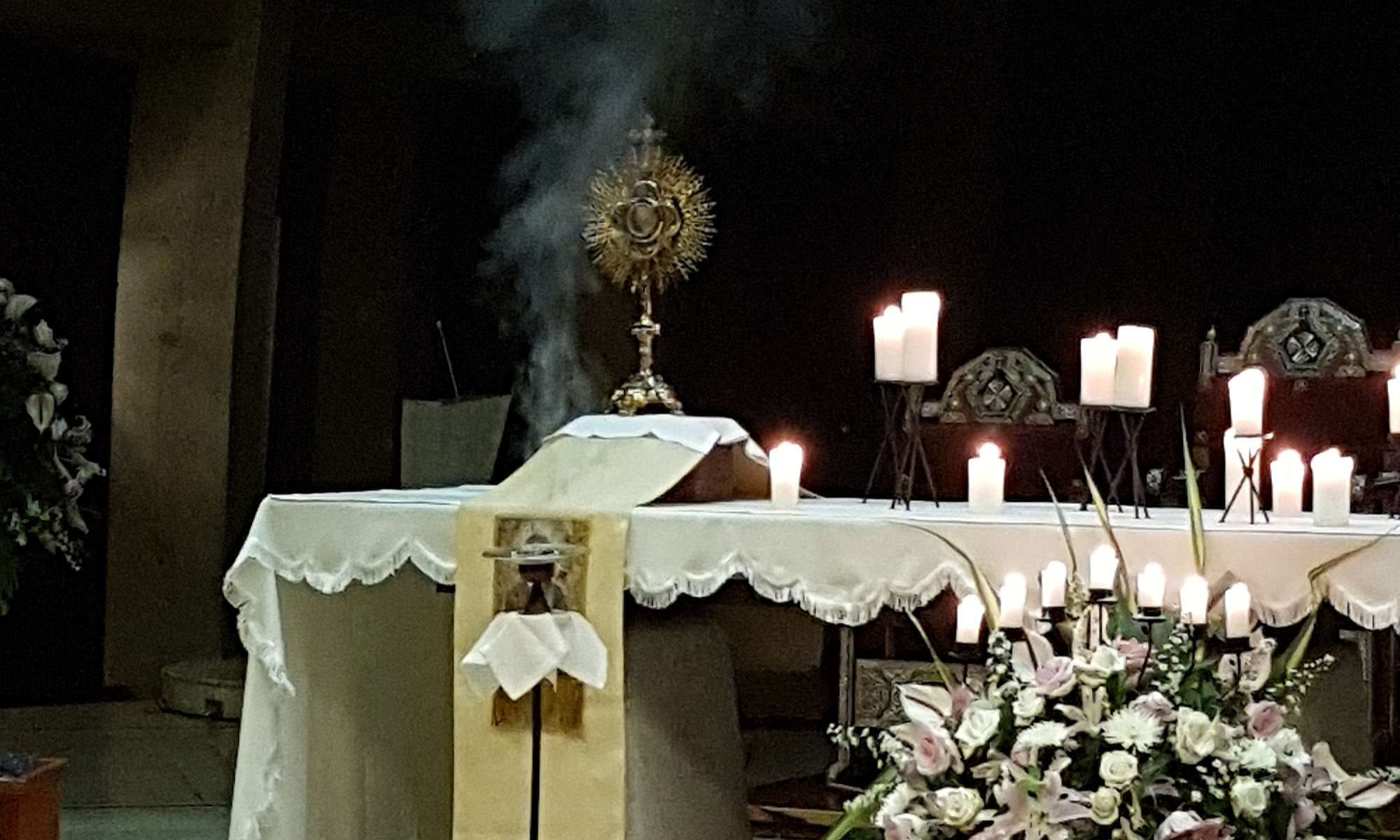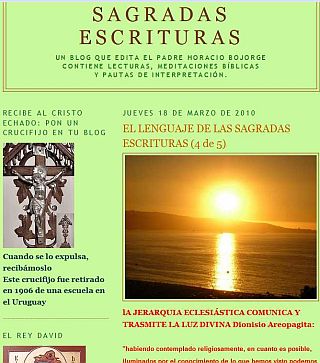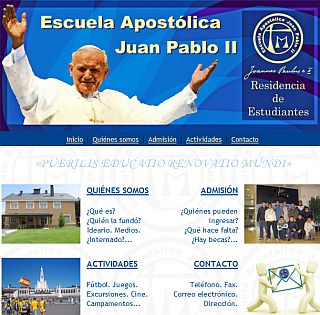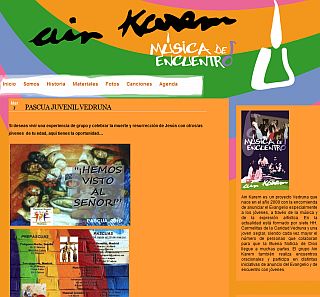Reflexión sobre las lecturas del domingo V de cuaresma, en el Ciclo C: Dios hace nuevas las cosas.
[Si estás leyendo esto en Facebook y deseas escuchar la predicación a la que aquí se hace referencia, haz click en “Publicación Original.”]

Alimento del Alma: Textos, Homilias, Conferencias de Fray Nelson Medina, O.P.
Reflexión sobre las lecturas del domingo V de cuaresma, en el Ciclo C: Dios hace nuevas las cosas.
[Si estás leyendo esto en Facebook y deseas escuchar la predicación a la que aquí se hace referencia, haz click en “Publicación Original.”]
Homilía para el Domingo No. 5 de la Cuaresma, en el ciclo C, sobre la escena de la mujer adúltera.
[Si estás leyendo esto en Facebook y deseas escuchar la predicación a la que aquí se hace referencia, haz click en “Publicación Original.”]

“Un blog que edita el Padre Horacio Bojorge. Contiene lecturas, meditaciones bíblicas y pautas de interpretación…” Click!
6. Para lograr el fruto de la Cruz es menester morir para nosotros mismos, o sea, renunciar a nosotros mismos, lo cual es antecedente de la Cruz, para luego permanecer con Cristo crucificados; de tal manera que Él sea quien tenga vida en nosotros, y ya no vivamos para nosotros sino vivamos por Él, en Él y para Él, hechos uno con su fe, esperanza y caridad, siendo testigos de la obra que Él realiza con la colaboración nuestra. De esta manera nos convertimos en testigos de su acción, la cual no es obstaculizada por nuestro mal, puesto que la Cruz lo somete.
Homilia para el domingo de la quinta semana de cuaresma, aprende con Cristo a tratar al pecador
[Si estás leyendo esto en Facebook y deseas escuchar la predicación a la que aquí se hace referencia, haz click en “Publicación Original.”]
Una homilía para el Domingo Quinto de Cuaresma en el Ciclo C, con énfasis en aquello de que Dios sabe sacarnos de los absurdos a los que nos lleva el pecado.
[Si estás leyendo esto en Facebook y deseas escuchar la predicación a la que aquí se hace referencia, haz click en “Publicación Original.”]

“El Proyecto “Cine y Vocación” nace como una humilde oferta de materiales vocacionales. Partimos de un hecho indiscutible: el cine es uno de los medios que más influye en los jóvenes y adolescentes. Es por ello un recurso pedagógico fundamental…” Click!
Homilia para el sábado de la cuarta semana de cuaresma, en ella se nos invita a dejarnos impactar por Jesus
[Si estás leyendo esto en Facebook y deseas escuchar la predicación a la que aquí se hace referencia, haz click en “Publicación Original.”]
Homilia para la Fiesta de San José, predicada en la Basílica de N. S. de Chiquinquirá.
[Si estás leyendo esto en Facebook y deseas escuchar la predicación a la que aquí se hace referencia, haz click en “Publicación Original.”]
En el centro de la cena pascual, ordenada según determinadas normas litúrgicas, estaba el cordero como símbolo de la liberación de la esclavitud en Egipto. Por este motivo, el haggadah pascual era parte integrante de la comida a base de cordero: el recuerdo narrativo de que había sido Dios mismo quien había liberado a Israel “con la mano alzada”. Él, el Dios misterioso y escondido, había sido más fuerte que el faraón, con todo el poder de que disponía. Israel no debía olvidar que Dios había tomado personalmente en sus manos la historia de su pueblo y que esta historia se basaba continuamente en la comunión con Dios. Israel no debía olvidarse de Dios.
Continuar leyendo “Cuando celebro Cristo la Cena de Pascua?”

“La Escuela Apostólica “Juan Pablo II” es una residencia de estudiantes para varones de secundaria y bachillerato. Ha sido fundada por el Instituto Secular “Servi Trinitatis”, instituto aprobado por la Iglesia y que tiene entre sus fines la educación de niños y jóvenes y el cultivo vocacional…” Click!
Homilia para el dia de la Solemnidad de San Jose, nos exhorta a ser como San Jose: puros y leales con Dios
[Si estás leyendo esto en Facebook y deseas escuchar la predicación a la que aquí se hace referencia, haz click en Publicación Original.”]
Sus exequias se han celebrado el 18 de Marzo de 2010. Yo fui invitado a predicar en una Eucaristía que se celebró el día en que falleció: el 17 de Marzo de 2010. En Abril hubiera cumplido 65 años de profesión religiosa, en el Monasterio de Santa Inés, de las Monjas Dominicas.
[Si estás leyendo esto en Facebook y deseas escuchar la predicación a la que aquí se hace referencia, haz click en “Publicación Original.”]

“Ain Karem es un proyecto Vedruna que nace en el año 2000 con la encomienda de anunciar el Evangelio especialmente a los jóvenes, a través de la música y de la expresión artística. En la actualidad está formado por siete HH. Carmelitas de la Caridad Vedruna y una joven seglar, siendo cada vez mayor el número de personas que colaboran para que la Buena Noticia de Dios llegue a muchas partes…” Click!
Homilia para el jueves de la cuarta semana de cuaresma, nos exhorta a buscar la Gloria de Dios en todo lo que hacemos y vivimos
[Si estás leyendo esto en Facebook y deseas escuchar la predicación a la que aquí se hace referencia, haz click en “Publicación Original.”]
Homilia para el miércoles de la cuarta semana de cuaresma, con una invitacion a caminar con alegría hacia el encuentro con Dios
[Si estás leyendo esto en Facebook y deseas escuchar la predicación a la que aquí se hace referencia, haz click en “Publicación Original.“]